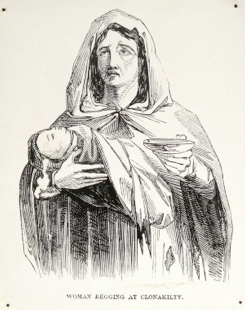My Town Matters and the Forbes House Museum are happy to offer a series of short stories and illustrations on Ireland’s Great Famine and its connection to Milton/Boston. The first feature article provided background information on Forbes House Museum’s association with the Famine. In this second article, readers are introduced to illustrator, James Mahony (c. 1816- c.1859), hired by the Illustrated London News to document the Great Famine through illustrations and personal reflection.
by Robin M. Tagliaferri, FHM Executive Director
The Forbes House Museum has been collaborating since 2011 with scholars and community groups from the United States and Ireland, researching Ireland’s Great Famine, which took place from 1845 to 1852.
In March 1847, at the height of the Great Famine, Captain Robert Bennet Forbes (1804- 1889), a member of the New England Relief Committee, commandeered an humanitarian voyage to Cork, Ireland, transporting 800 tons of food and other provisions aboard the USS Jamestown.
A noted and widely traveled illustrator and watercolorist, James Mahony (also spelled Mahoney) is ranked among the most important artists of 19th century Ireland. There is little documented information about Mahony’s life, especially his early years. In fact, his life dates are still in dispute, as some claim that he lived from 1816- 1859, while others report his dates as 1810- 1879. We know that Mahony was born in Cork, Ireland, the son of a joiner. It is believed that he spent several years in the European mainland studying drawing and painting in Rome. He achieved fame with his watercolor paintings of townscapes of Rome, Venice, Paris and Rouen, and from 1842-46, exhibited at the prestigious Royal Hibernian Academy in Dublin. From 1846-49, Mahony worked for the Illustrated London News, who sent him to West Cork, Ireland, the region most effected by the Great Famine. The printed engravings of Mahony’s illustrations brought shock to readers in England and abroad, documenting the unfolding height of the tragedy and mobilizing public opinion to action.
The Illustrated London News (ILN) of 13 February 1847 states the details of Mahony’s assignment:
“With the object of ascertaining the accuracy of the frightful statements received from the West [of Ireland], and of placing them in unexaggerated fidelity before our readers, a few days since, we commissioned our Artist, Mr. James Mahoney, of Cork, to visit a seat of extreme suffering, viz., Skibbereen and its vicinity; and we now submit to our readers the graphic results of his journey, accompanied by such descriptive notes as he was enabled to collect whilst sketching the fearful incidents and desolate localities; premising merely, that our Artist must already have been somewhat familiar with such scenes of suffering in his own locality, (Cork), so that he cannot be supposed to have taken an extreme view of the greater misery at Skibbereen.”
Upon arriving in Clonakilty, West Cork, Mohony provides commentary for this illustration of a woman and her baby:
“Woman Begging at Clonakilty,” by James Mohony, Illustrated London News, 13 February 1847, from the news article, “Sketches in the West of Ireland.” This actual printed copy was displayed in the 1967 exhibition at the Forbes House Museum, “Massachusetts Help to Ireland During the Great Famine.” Notice the pin marks at the corners. FHM permanent collection.
“I started from Cork, by the mail (says our informant), for Skibbereen and saw little until we came to Clonakilty, where the coach stopped for breakfast; and here, for the first time, the horrors of the poverty became visible, in the vast number of famished poor, who flocked around the coach to beg alms: amongst them was a woman carrying in her arms the corpse of a fine child, and making the most distressing appeal to the passengers for aid to enable her to purchase a coffin and bury her dear little baby. ??This horrible spectacle induced me to make some inquiry about her, when I learned from the people of the hotel that each day brings dozens of such applicants into the town.”
The Forbes House Museum is very grateful to 02186/May Town Matters and its editor, Frank Schroth for the opportunity to submit feature articles to the public. A third installation in the series, “Forbes House Museum and Ireland’s Great Famine: Who Knows the Story?” will appear later this month, on 18 December.
Sources/Credits for this article include:
- http://www.visual-arts-cork.com/biographies-of-irish-artists/james-mahoney.htm
- http://www.visual-arts-cork.com/
- http://www.nationalgallery.ie/
- http://viewsofthefamine.wordpress.com/
- http://viewsofthefamine.wordpress.com/illustrated-london-news/sketches-in-the-west-of-ireland/
- https://www.awesomestories.com/asset/view/Irish-Potato-Famine-Begging-Mothers//1
